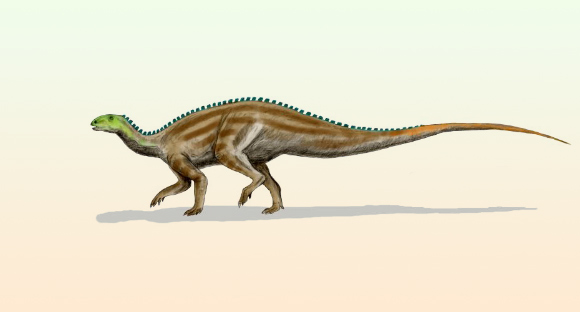Paleontologists from the New Mexico Museum of Natural History and Science, the University of Texas at El Paso and Montana State University have discovered the fossil bones of Tenontosaurus sp. — an Early Cretaceous ornithopod dinosaur from North America — in the Yucca Formation in far West Texas, the United States. This southernmost record of a tenontosaur in the Western Interior is about 400 km east of Arizona records and about 900 km southwest of its records in north-central Texas.

Life restoration of Tenontosaurus tilletti. Image credit: Nobu Tamura, http://spinops.blogspot.com.
Tenontosaurus is a genus of iguanodontian ornithopod dinosaurs that lived in North America during the Early Cretaceous, around 115 million years ago.
Two members of the genus are known: Tenontosaurus tilletti and Tenontosaurus dossi.
They had an unusually long, broad tail, which like its back was stiffened with a network of bony tendons.
The new Tenontosaurus fossils were collected from the Upper Yucca Formation in the Indio Mountains, approximately 35 km southwest of Van Horn, West Texas.
“I wasn’t out looking for fossils that day,” said Dr. Jason Ricketts, a paleontologist at the University of Texas at El Paso.
“I was studying the rocks in the area when I noticed fragments weathering out of soft shale.”
“There was no need to excavate — I simply picked them up. It was an unexpected and exciting find, and my family even came out with me to help collect the pieces.”
“Dinosaur fossil discoveries in West Texas are rare, and the finding of fossilized bones, rather than just footprints, is especially uncommon.”
“The fossils were found as individual fragments, with the largest identified as part of a femur leg bone.”
“Although incomplete, the fossils have significant scientific value,” he said.
“Before this discovery, the nearest places where similar fossils had been found were Montana, Idaho, Arizona, and other parts of Texas.”
This discovery extends the known range of Tenontosaurus farther southwest than previously documented.
“Until now, fossils of this species were known primarily from localities farther north and east, such as Utah and Wyoming,” Dr. Ricketts said.
“This finding shows that Tenontosaurus lived as far south as West Texas.”
While the fossil fragments are still being studied, the authors hope the discovery will inspire further exploration in West Texas, a region that remains largely underexplored for dinosaur fossils.
“This discovery shows that there’s still much to learn about our region’s prehistoric past,” Dr. Ricketts said.
“It’s a privilege to contribute even a small piece to that bigger story.”
The discovery is reported in a paper published in the NM Museum of Natural History and Science Bulletin.
_____
Spencer G. Lucas et al. 2025. An ornithopod dinosaur from the Lower Cretaceous of West Texas. NM Museum of Natural History and Science Bulletin 101: 291-294







